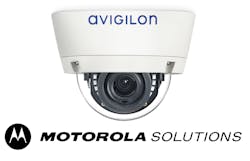In a move long rumored but only surprising due to its acquisition partner, Avigilon, the Canadian-based developer and manufacturer of video surveillance software and hardware, became a member of the Motorola Solutions family on February 1 in an all-cash transaction worth approximately one billion U.S. dollars.
According to Jon Cropley, a principal analyst in the video surveillance market for the research firm IHS Markit, the expectations were for Avigilon to be the acquisition target of one its technology competitors, not a company with a limited footprint in the video marketplace; however, the fit makes sense from Motorola’s perspective – considering its continued expansion into the safe cities and public safety sectors.
“Motorola's focus on public safety projects is likely to have been a major motivation for the acquisition,” Cropley says. “City surveillance is an important element of public safety, and professional video surveillance equipment revenue has been growing faster in the city surveillance sector than in the rest of the market in recent years.”
Cropley adds that the city surveillance sector continues its strong growth compounding at an annual growth rate (CAGR) of 11.1 percent to 2021 – and the total market growing at a CAGR of 6.8 percent. Additionally, IHS Markit estimates Avigilon was the eighth-largest supplier of professional video surveillance equipment in 2016 with more than 2 percent of global market share, worth $15.4 billion.
Motorola has been on an acquisition spree over the last three years, with recent acquisitions including the UK TETRA operator Airwave, the U.S.-based 911 business of Airbus DS Communications, Kodiak (a push-to-talk provider) and Spillman (a public safety software provider). These acquisitions, along with the purchase of Avigilon, are a clear indicator that Motorola is looking to expand its influence in the public safety and ‘safe city’ market, moving beyond its emergency communications focus of the past.
Traction of national public safety broadband networks such as ESN and FirstNet, which facilitate video integration, further supports this strategic play.
“Avigilon is a video platform business with an end-to-end system of cameras, analytics, video management and video storage that will add new products and technologies to our portfolio,” Motorola Solutions’ Director of Media Relations Steve Gorecki said in a statement. “We see opportunities for growth in Avigilon’s commercial segment, with a direct extension to our public safety customers. Part of the value was (Avigilon’s) dealer and integrator channel, and we plan to continue to use them. This transaction is about growth acceleration and (Motorola) intends it to be as business as usual.”
IHS Markit estimated Motorola held approximately seven percent of the nearly $5 billion command and control technologies and services market in 2017, making it the largest supplier to that market.
Another possible factor in the acquisition – according to a Bloomberg Technology article quoting Motorola Chief Executive Officer Gregory Brown – was an opportunity to move into the critical infrastructure video space in response to cybersecurity concerns with Chinese video surveillance solutions providers. The Bloomberg article quotes Brown: “There is a just concern with the security of Chinese video technology, especially around critical infrastructure communications.”
As more cameras feed into public safety workflows, video surveillance and analytics will enable more public-private partnerships between local communities and law enforcement. The acquisition will also enable Motorola Solutions to extend into new segments of its commercial markets business, which provides secure, reliable communications technology to industries such as oil and gas, transportation, utilities, manufacturing and higher education.
Customers will now be able to purchase advanced security and surveillance solutions as part of Motorola Solutions’ portfolio of critical communications technology for commercial markets.
“The acquisition will bring Avigilon’s advanced video surveillance and analytics platform to the rapidly evolving public safety workflow,” Gorecki said. “Video can serve as highly efficient ‘eyes and ears’ for monitoring a given location. Advanced video analytics can monitor wide areas with high levels of accuracy and proactively alert officials to a perimeter breach or quickly find a person who left behind an object of interest.
“It also will enable more public-private partnerships between local communities and law enforcement,” Gorecki added. “One example is Detroit’s Project Green Light, which has seen a significant reduction in violent crime among local businesses whose high-definition cameras live-stream directly to the Detroit Police Department.”
Steve Lasky is the Editorial Director of SouthComm Security Media, which includes print publications Security Technology Executive, Security Dealer & Integrator, Locksmith Ledger Int’l and the world’s most trafficked security web portal SecurityInfoWatch.com. He is a 30-year veteran of the security industry and a 27-year member of ASIS.



